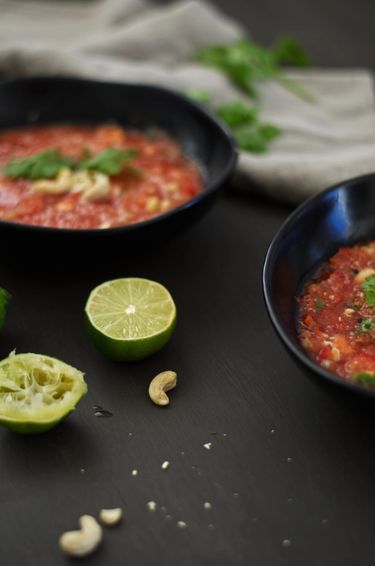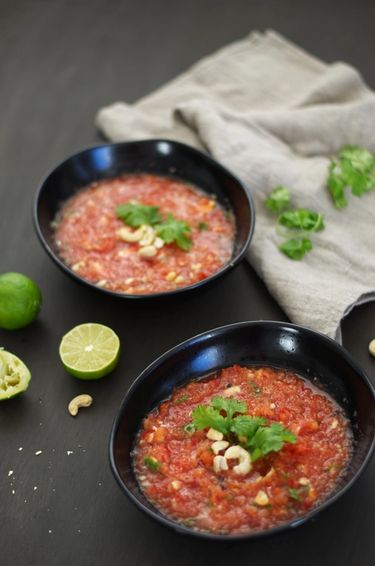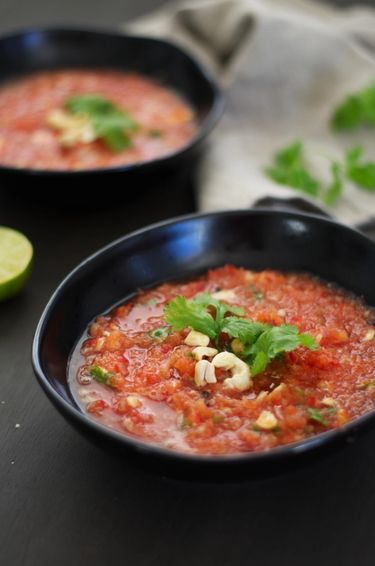If you enjoy this article, or any other content from this website, please subscribe to the newsletter. Your support can make a big difference!
I’m not sure about you, but I can’t seem to escape the heat. We just returned from a week-long mountain retreat in the Alps and it was steaming hot up there as well!
As an islander, this heat always makes me crave a dip in the sea — so much so that I convinced myself to dive into a freezing-cold mountain lake. All those who know me know that my minimum sea temperature is about 20 degrees, so no one would at first believe that I made such a bold move.
Apart from refreshing dips in the sea, I’ve been craving my all-time summer fruit: watermelon. Watermelons are a wonderful and fresh way to stay hydrated and happy. And because I’m a massive fan of sweet and savoury dishes, watermelon is perfect for just that! Enter watermelon gazpacho.
What is Gazpacho?
Even if you love cooking, in the heat of the summer, sometimes turning on your stove is the last thing you want to do. But you still have to eat, right?
Gazpacho is your solution!
You can make a huge batch of fresh, hearty soup without having to heat anything up or feel the weight of a heavy, winter soup.
Wait, is gazpacho served cold?
It sure is. The key to a great gazpacho is using the freshest and best quality ingredients. For those who aren't familiar with gazpacho, the traditional Andalucian gazpacho (in Spain) is probably the best known. The ingredients for gazpacho typically include tomatoes, bell pepper, onion and cucumber. It’s always blended with extra virgin olive oil and a splash of Sherry vinegar. It has even been described as a 'liquid salad' due to its fresh, healthy (salad) ingredients.
Is gazpacho the main dish?
You can gazpacho as your main dish or as an appetizer. If you’re feeling like a light afternoon snack, gazpacho can be perfect for the occasion. You can also serve a bowl as a starter, or a side to your dish. For instance, I would pair it with pan-fried garlic prawns, delicious crusty bread or a delicious vegetarian quinoa biryani like this one here!
Today, there are all sorts of gazpacho, from keto gazpacho to vegan gazpacho. They can be made from vegetables like carrot and beet gazpacho to fruit gazpachos like my watermelon gazpacho or mango gazpacho. This is a soup of individuals: you can pretty much blend any fruit or veg to the consistency that you like, and garnish it however you like.
The history of Gazpacho
Want to know about gazpacho’s origin? Read Don Quixote!
“A reaping-hook fits my hand better than a governor’s sceptre; I’d rather have my fill of gazpacho’ than be subject to the misery of a meddling doctor…” — Miguel de Cervantes, The Ingenious Hidalgo Don Quixote, II, Ch. 53
Drawing from the culinary traditions of Arab and Roman culture, the history of gazpacho is a wonderful and eclectic one. Firstly, the name “gazpacho” is derived from the Mozarabic (Spanish Christians living under Moorish rule) word caspa meaning “fragments,” referencing the small pieces of bread which were ripped up and served with the soup.
The introduction of New World and Asian ingredients such as tomatoes and cucumbers respectively helped make gazpacho a standard Spanish dish, first in the province of Andalusia. It was enjoyed both by the poor and the rich.
In the past, gazpacho was quite different from how we know it today. It started off as a hearty soup that could include whatever vegetable was on hand, and a great way to use up old bread, so as nothing went to waste. Originally, bread crusts were soaked in water and placed in a sauce of anchovy bones, garlic, vinegar, sugar, salt, and olive oil, until the bread softened and various fruits and vegetables were added. In fact, gazpacho was not always necessarily served cold — as it was also served hot during the winter, a tradition deriving from the Arab occupation of Spain from the eighth to the thirteenth centuries. However, the use of vinegar in gazpachos served cold like the popular Andalusian gazpacho, refer to the Roman tradition of adding vinegar to food for refreshment during warm weather.
Besides its prevalence as a common tasty dish, gazpacho was used for medicinal purposes as well. Although medicinal properties are no longer attributed to the meal, gazpacho still has a pervasive presence in the modern world. The variability and simplicity of this recipe make it a thriving survivor of the early modern period.
Watermelon gazpacho
This delicious and refreshing twist on the classic Spanish gazpacho replaces tomatoes with fresh watermelon (only make this when watermelon is in season!). My watermelon gazpacho is not so much focused on the traditional Andalusian gazpacho in that I use herbs and spices like fresh coriander, sesame oil, cashews and chilli. Despite it being different, it is just as simple as any standard gazpacho, in that it requires little more than a blender and a refrigerator. If you want to be bold, I dare you to add a dash of fish sauce!
Gazpacho is a simple dish with a lot of flavour. Better yet? It’s a health-food; it is, after all, a 'liquid salad'. Calories in gazpacho tend to be on the low side as the added oil is the only fat source. The rest of the ingredients have high fibre content!
Make sure to use the best and most fresh ingredients as this is a raw dish, as it's the ingredients that make it or break it. Go for organic if possible, too.
Prevent food waste by using the watermelon rind
Watermelon rind is the white flesh that sits between the red flesh of the watermelon and the green shell of the watermelon. That part is actually edible and can be used in pickles, chutneys, curries, gazpachos and other soups. For a sweet treat, they can also be candied! Why waste it!
How to make watermelon gazpacho
Grab your ingredients and throw them in a blender. Half kidding. You may want to roughly dice them up first!
The ingredients I use in this dish are:
- Seasonal watermelon (including the watermelon rind you would normally throw away)
- Cucumber
- Shallots
- Toasted sesame oil
- Cashews
- Coriander
- Red chilli
- Red bell pepper
- Red wine vinegar
- Lime
- Salt to taste

How to store gazpacho
Gazpacho is as easy to store as it is to make. The simplest way to store gazpacho is in your fridge.
How long does gazpacho last in the refrigerator?
The gazpacho should last in your fridge for 4 – 5 days. You may want to check on your soup after a few days, just to be sure it is still smelling delicious and looking fresh.
If you’re used to batch-cooking your meals to save time, you may be wondering if you can freeze gazpacho.
So can you freeze gazpacho?
Yes, you can make a huge batch of gazpacho and freeze it to last you through the entire summer.
How To Freeze Gazpacho
Glass freezer-safe Tupperware container, preferably glass are best. It's better for the environment and cleans better. Also, storing liquids in plastic for extended periods of time is not ideal because you increase the risk of allowing potentially harmful toxins into your food.
Make sure you leave about 1 inch of space on the surface because it will expand a bit, and you want there to be room to grow. It’s always a good idea to write the date of freezing on your containers. Try to consume your soup within 6 – 8 months.
How to Thaw Frozen Gazpacho
It’s best to know ahead of time when you’re going to want to eat your gazpacho again so that you can let it thaw in the fridge. Since this is a soup you serve cold, you definitely don’t want to try defrosting it in your microwave.
You can let it thaw on your counter to save some time and then let it finish defrosting in your fridge. It’s easiest to simply let it thaw overnight, the day before you want to serve it.
You will definitely want to give it a good stir before serving it.

Chunky Watermelon Gazpacho with Cashews
No reviews yet
Description
A delicious, chilled watermelon gazpacho
Information
- Servings
- 4persons (as an appetizer)
- Preparation time
- 5minutes
- Cooking time
- 10minutes
Ingredients
- 400grwatermelon chunks and rind, with seeds removed
- 40grred bell pepper
- 40grcucumber, peeled, deseeded and chopped
- 20grshallots, chopped
- 5grcoriander, shredded
- 40grcashews (reserve 15g for garnishing)
- 15mlred wine vinegar
- 15mltoasted sesame oil
- 1lime, squeezed
- 1medium red chilli, deseeded
- —salt, to taste
Method
1. Prepare the ingredients
Roughly chop the cucumber, red bell pepper, watermelon flesh (including the rind) and the red onions. Make sure you are using the best quality fruits and vegetables possible—gazpacho is a raw dish.
2. Blend the ingredients
Place the chopped watermelon rind, cucumber, red bell pepper and onions in a blender. Add the watermelon, half of the roasted cashews, fresh coriander, sesame oil and the deseeded chili and blend. For a chunky texture, the best would be to pulse the soup until you reach the desired texture.
3. Taste and adjust seasoning
Add salt to taste (go easy, you can always add more later), the lime juice and a couple of splashes of vinegar and blend. Everyone has a different preference on how much vinegar to add, so my advice is to start with a teaspoon or two and adjust at the end. Finally, slowly add in the toasted sesame oil as the blender is running.
4. Chill the gazpacho
Pour the watermelon gazpacho into small bowls or jars and chill in the fridge until serving. When serving, sprinkle some crushed cashews on top and garnish with some fresh coriander leaves.

If you're not up for eating watermelon gazpacho, why not try this equally refreshing vegan cucumber soup by Eating Works.
